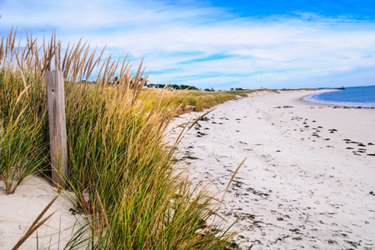Determining The Value Of Clean Water: How EPA Researchers Are Using Social Science To Study The Human Dimensions Of Water Quality In New England
By U.S. EPA

Coasts and estuaries are highly valued and provide important resources for communities. These environments provide ecosystem services including food, recreational space, protection from storms, and more. In New England, coastal water quality is particularly important for local communities and economies, with beaches and aquatic environments drawing in millions of visitors each year.
To help protect these important areas, EPA researchers are using social science to study the value that people place on water quality in coastal environments. Using an interdisciplinary approach, EPA scientists are learning more about the human dimensions of water quality through their research on environmental justice and water quality, best practices for public engagement to work collaboratively on improving water quality, and the values people have for coastal recreation. This work allows environmental managers, decision-makers, and individual community members to better understand the value of investing resources into water quality improvements and protection of natural environments.
Characterizing People’s Values For The Coast
One way EPA researchers are examining the relationship between humans and coastal water quality is by studying how people use the coast for recreation. Using several different methods — including physically counting visitors to a recreational area, modeling data collected from surveys, and applying anonymized cell phone data — EPA social scientists predict daily, monthly, and annual visitors to coastal areas. This allows researchers to better understand the impact that New England coasts have on travel and recreation, and it provides baseline data for estimating the impact of events that reduce water quality, such as harmful algal blooms.
“We can learn from observations of where people go and where they are coming from to infer their preferences and values for coastal water quality,” said EPA social scientist Nate Merrill. “We are working on methods to collect these observations at scale.”
In addition to measuring visitors to coastal areas, EPA researchers are determining how water quality affects recreation and visitation to the coast. This helps scientists understand how reduced water quality events such as bacterial closures affect the number of visitors and perceptions of water quality. Using summaries of previously published studies and their own surveys, EPA researchers collected data to determine costs associated with beach closures, as well as the economic value people place on visits to the coast with varying levels of water quality. They found that many people highly value coastal areas for recreation, and that these values are affected by changes in water quality such as beach closures, reduction in water clarity, and more. This research allows scientists to better quantify the value of coastal recreational spaces and helps environmental managers advocate for water quality improvement resources using an economic lens.
Equitable Access To Clean Coasts
EPA researchers are also studying different communities’ access to clean coastal and estuarine environments. While access to clean outdoor spaces improves quality of life, this access is not equal among all people. Results of one study on coastal access in Rhode Island found communities of color were farther from clean water and access points and had to spend more money to access clean recreational areas compared to communities with higher proportions of white populations. Ongoing research is estimating differences in recreational experiences and uses of coastal areas based on income and racial identities.
This research provides key information on the current state of environmental justice issues so that communities can work towards equitable access to clean coastal environments.
“We are working on considerations of environmental justice and water through multiple lenses. Environmental justice is complex but worth working towards,” noted EPA social scientist Kate Mulvaney. “It will take these varied methods as well as critical contributions from communities and a slate of other expertise to best understand the impacts on key communities.”
Water Quality And Public Engagement
To reach EPA’s goals of having clean outdoor spaces, effective water policy, and valuable environmental research, our scientists are working to determine the best ways to engage with communities about water quality. EPA researchers are improving our knowledge of best practices for public engagement by studying the science of science communication and how people are adopting pollution-mitigating technologies at home. Bringing scientists and key communities together allows for interdisciplinary collaboration and allows different groups of people to use their strengths to solve environmental issues together.
“For science communication to be effective, we need to do more than just share scientific information with relevant communities,” EPA social scientist Kaytee Canfield said. “Understanding the priorities, cultures, and concerns of the communities with whom we are communicating can improve messaging and better protect both people and the environment.”
